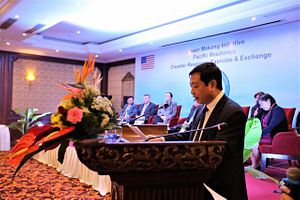Last week, the United States and Vietnam jointly launched the most recent iteration of what has become an annual disaster response exercise and exchange for the mainland Southeast Asian states along the Mekong River, one of the world’s largest, longest, and most resource-rich rivers. The initiative was yet another indication of the ongoing, wider U.S. subregional cooperation with the countries in the Mekong region, which is a subset of U.S. ties with Southeast Asia.
As I have noted before in these pages, one of the key manifestations of subregional U.S. cooperation with Southeast Asian states under the Obama administration as part of its wider rebalance to the Asia-Pacific was the Lower Mekong Initiative (LMI). The LMI, officially launched in 2009, was intended to boost sustainable development and capacity-building for the countries that lie along the Mekong River – Cambodia, Laos, Myanmar, Thailand, and Vietnam.
Despite continued concerns about resourcing as well as comparisons – far too often ill-informed – to China’s own Lancang Mekong Cooperation Mechanism, the LMI has continued to move along under the Trump administration (See: “Trump’s Real ASEAN Test”). The last ministerial meeting was held back in August and attended by Secretary of State Rex Tillerson, and working group meetings have been held since as well. Discussions are also ongoing on how to adjust existing collaboration – which is now organized around six pillars – as well as new initiatives that have been proposed by the United States in the areas of sustainable infrastructure and water data.
One of the events within the LMI on the defense side that has been continuing on is the LMI Disaster Response Exercise and Exchange (DREE), an annual multinational exercise sponsored by U.S. Pacific Command (PACOM) under the Pacific Resilience series of exercises that it holds throughout the Asia-Pacific region. LMI DREE’s objective is to boost regional readiness to tackle all-hazard situations in the Lower Mekong by advancing integrated subregional cooperation.
From December 5 to December 9, the latest LMI DREE activity was held in Hue, Vietnam following its launch by the U.S. Army Pacific (USARPAC) and the Vietnam Ministry of Agriculture and Rural Development (MARD). The emphasis of this year’s exercise was on flood response in the Lower Mekong, a key issue for Vietnam given the country’s longer term concerns around climate change as well as more immediate natural disasters. Typhoon Damree, which hit last month, claimed over a hundred lives.
According to the U.S. Army, the exercise comprised a variety of activities, including working groups with panel sessions to discuss topics and promote communication and information sharing; a site survey where participants traveled to a dam near the mouth of the Perfume River in Hue; and a table top exercise (TTX) where member states worked together to develop solutions to a disaster scenario.
All in all, over 100 disaster management experts from a range of government and international organizations participated in this iteration of LMI DREE. The next exercise is set to be held in Thailand next year.

































